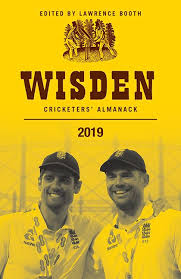Wisden Cricketers’ Almanack 2019
David Taylor |Published: 2019
Pages: 1539
Author: Booth, Lawrence (Editor)
Publisher: John Wisden
Rating: 5 stars

What’s the lowest total ever recorded in international cricket?
You probably think you know the answer to that one. You’re almost certainly wrong. In fact, I’d guess that you’ve been wrong for some eleven years.
Coverage of the constant expansion of the world game is perhaps one of the lesser recognised aspects of sport’s most enduring annual publication, which as usual appeared in early April – though no longer in time for the first-class season, which for some reason now begins with university matches against counties at the end of March. On occasions in the 19th century first-class cricket continued into October and perhaps this will be the way forward in future, following the lead of football’s determination to stretch its season until the end of May.
Lawrence Booth is too modest to include himself under ‘Other Cricketing Notables’ alongside earlier editors, but he is in his eighth edition now, and he is well into his stride. His notes make splendid reading as usual. Space doesn’t permit me to quote at length, but he is no more than cautiously optimistic for the future of the English game, given the inevitable coming of the ‘Hundred.’ Along with many of us he wonders who actually wanted this new development. He does, though, note the recently lowered strike rate of England’s Ben Stokes, and reminds him that “it’s OK to hit out, as long as you choose the right target.”
The cover features Alastair Cook and James Anderson – England’s highest run scorer and wicket taker in Test cricket. I understand why the Editor wanted those two on the cover, though as Cook has featured before I would like to have seen Anderson and Stuart Broad, our two highest wicket takers – bowlers so often get a raw deal. Perhaps Broad will feature next year if he bowls England to a fifth consecutive home Ashes triumph. Each section in the almanack is also introduced by a photograph (uncaptioned) – most are easily identified, but I found myself unsure of the handsome chap on p. 1463 – John Woodcock or Keith Miller would be my guess. I’m sure Martin can put me right.
The meat of the almanack is found in the features, book reviews and obituaries which form the first 250 or so pages. Thereafter we’re into series reports, averages, county reports, scorecards and so on. The features are uniformly excellent and wide-ranging. There are pieces on Imran Khan, on the 1979 World Cup (of particular interest to me, as the first one I followed), on Lord’s match tickets, an extremely amusing transcript of the 2018 Wisden dinner speech as given by actor Miles Jupp, and a perceptive and poignant piece on the ‘Windrush’ generation of black English cricketers, featuring interviews with the likes of Phil DeFreitas, Chris Lewis and Devon Malcolm. Ball tampering, inevitably, is another issue that attracts attention. There are also the ‘Five Cricketers of the Year’ of course. If last year was the ‘MeToo’ Wisden, with three female players chosen along with one on the cover, this year has just one – England’s Tammy Beaumont – along with four men. Dare I say it, perhaps this more accurately reflects worldwide interest in the world game. There is no doubt though that the stature of the women’s game has grown enormously and it is quite right that coverage in the almanack reflects this. You are not going to find me referring to the current tournament as the ‘men’s cricket world cup’ though.
Little gems leap out at you from every page. Anderson had a perfectly symmetrical year in 2018 – 43 runs and 43 wickets in Tests; retiring bowler Jack Shantry’s distinctive action was described by his brother as ‘a cry for help’; John Manners of Hampshire, born a month after the start of the first World War is the last surviving county player from before the Second, though Eileen Ash, then Whelan, is his senior by almost three years and took part in the first Women’s Ashes in 1934-35 (with advancing years, I find myself more interested in the longevity of others); Alan Oakman, of Sussex, Warwickshire and England, received news of his England call-up in 1956 from a policeman because his house had no telephone. It is just as well that he answered the door, because he took five catches as Jim Laker helped himself to nineteen Australian wickets.
I could go on … space has been the problem of many editors over the years, and it’s been a while since the Laws appeared, although there’s still room (for now) for Events in Cricket History. The Chronicle of 2018 is illustrated, as usual, by splendid cartoons by Nick Newman. The records section continues to shrink, even as the world game grows. What’s the lowest total in international cricket? Why, it’s 18 – by the Mexico Women’s team against Brazil in 2018-19, of course. Although, the text tells us that in early 2019 China surpassed this, if that’s the right word, with 14 against the UAE. All T20 internationals, women’s and now men’s, have been given official status. Be prepared for some horror stories.
In the six or seven weeks I’ve been reading this book (and if I’m honest I haven’t read 20 per cent of it yet, it’s not the sort of book one reads from cover to cover, though some of the old timers claimed to do so), I’ve been thinking about how I could improve on it. I’ve concluded that I couldn’t. And though I’m sure that Wisden aficionados could find holes to pick here and there, I find no reason not to give the 2019 Almanack five stars – and try to find space on the bookshelf alongside its 72 companions.






Leave a comment